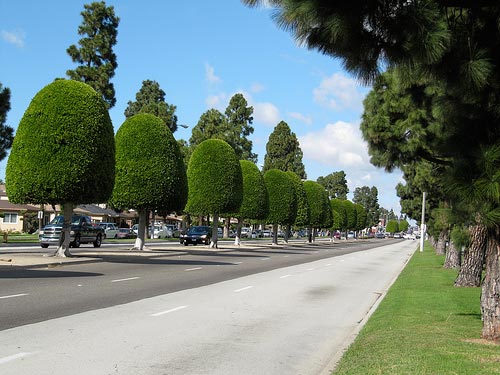
The space shuttle Endeavour has successfully completed 4,600 trips around the Earth, but the trip from LAX airport to the California Science Center, where it will spend its retirement, is proving to be a challenge on another frontier.
The shuttle is too tall to clear overpasses on the highway route, too heavy to be airlifted and too delicate to be disassembled for transport. With all other options exhausted, the center and city officials have resorted to cutting down approximately 400 trees to allow the five-story-tall, 162,000-pound spacecraft to pass through the city streets. The trees include mature pines, magnolias, ficus and myrtles. Cutting has already begun in Inglewood.
“Mission 26,” as the October 12 trip has been dubbed following Endeavour’s 25 space missions, is slated to be a two-day parade and citywide celebration. “Los Angeles is a world-class city that deserves an out-of-this-world-attraction like the Endeavour,” says Los Angeles Mayor Antonio Villaraigosa in a statement on the matter. “We welcome the shuttle with open arms.” Some residents agree. “I’m really excited to see the Endeavour. It’s a once in a lifetime chance,” one resident told NBC Nightly News.

Not all residents are pleased, though. “It’s unacceptable to cut down oxygen-giving species just to let something pass by. I would love to see the shuttle housed here, but I don’t think we should lose trees that are 40, 60 years old,” West Area Neighborhood Council Board Member Johnnie Raines tells The Guardian. Los Angeles is a hot city and residents depend on their urban forests to shade the streets. The EPA says that shaded surfaces can be between 20 and 45 degrees cooler than “peak temperatures of unshaded materials,” such as an L.A. sidewalk in the sun. Many also worry about the effect losing the trees will have on property values in this already tough economy.
That’s why, as residents in Inglewood mourn their loss, residents four miles away may be celebrating their own trees’ close call. A shorter route that would also have required cutting trees was considered, but rejected partially due to the trees’ cultural significance. Leimert Boulevard’s pines and firs — planted in honor of Martin Luther King, Jr. — have been spared.
The California Science Center will plant two trees for every one that is cut, but it will be decades before these saplings are able to provide the same environmental benefits as the trees that currently line these neighborhood streets. On the other hand, officials have said that the new trees will be more appropriate for the climate. Currently, the neighborhood’s trees consist largely of moisture-loving species like crape myrtles and sweetgum, both of which require heavy watering in dry, hot southern California.
All parties agree that searching for the best solution for city neighborhoods is, indeed, an endeavor.